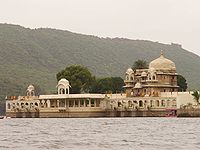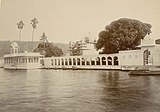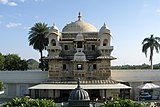Jag Mandir
| Jag Mandir | |
|---|---|
 Jag Mandir with sculpture of eight elephants adorning the entrance and facing the Lake Palace | |
 Jag Mandir with sculpture of eight elephants adorning the entrance and facing the Lake Palace | |
| General information | |
| Architectural style | Rajput architecture |
| Town or city | Udaipur |
| Country | India |
| Coordinates | 24°34′02″N 73°40′41″E / 24.5672°N 73.6781°ECoordinates: 24°34′02″N 73°40′41″E / 24.5672°N 73.6781°E |
| Construction started | 1551 |
| Completed | Mid 17th century |
| Client | Maharana Jagat Singh I |
| Owner | Arvind Singh Mewar |
| Technical details | |
| Structural system | Yellow Sandstone and Marble |
Jag Mandir is a palace built on an island in the Lake Pichola. It is also called the "Lake Garden Palace". The palace is located in Udaipur city in the Indian state of Rajasthan. Its construction is credited to three Maharanas of the Sisodia Rajputs of Mewar kingdom. The construction of the palace was started in 1551 by Maharana Amar Singh, continued by Maharana Karan Singh (1620–1628) and finally completed by Maharana Jagat Singh I (1628–1652). It is named as "Jagat Mandir" in honour of the last named Maharana Jagat Singh. The royal family used the palace as a summer resort and pleasure palace for holding parties.[1][2][3][4][5] The palace served as a refuge to asylum seekers on two occasions.[1][6]
Geography[edit | edit source]
Jag Mandir is situated in one of the two natural islands in the Pichola lake (named after the village Picholi nearby), on its southern end. The lake was initially created in the 15th century by a local banjara tribal chieftain for carrying grain across the streams. During the reign of Maharana Udai Singh II, in 1560, the lake was substantially enlarged by constructing dams across two streams. At that time, the Maharana also built the Jag Mandir and the Lake Palace (Jag Niwas Hotel) on islands in the midst of the lake. Udaipur city with its City Palace and other monuments and temples were built on the periphery of the lake.[7][8]
History[edit | edit source]
Jag Mandir's history begins with the Maharana Karan Singh's benevolence shown to Emperor Shahjahan (1628–1648). Shahjahan, before he was crowned as Mughal Emperor, was known during his young days as Prince Khurram. As Khurram, he rebelled against his father Emperor Jahangir in 1623, because he wanted to be the heir to the Mughal throne. Faced with the danger of getting thwarted in his campaign, he sought refuge in the Mewar Kingdom at Udaipur, where he was given safe haven by the then Maharana Karan Singh (it is said that this courtesy was extended because Khurram's mother was a Rajput Hindu lady). He was initially kept in the City Palace along with his wife Mumtaz Mahal and his two sons, Prince Dara and Prince Aurangzeb. Later they were shifted to the Gul Mahal, as a safe refuge, in the midst of the lake (this place since then has also been called Khurram's Palace). Gul Mahal is a domed pavilion that was specially built for Khurram by Maharana Karan Singh. It was later enlarged by his son Jagat Singh into a huge palace and named as the Jag Mandir Palace. Khurram remained under Mewar's protection during 1623–1624.[1][3][4]
The irony of this act of hospitality shown by Karan Singh to Khurram is that his father Maharana Amar Singh had been defeated in the war in 1614 by Khurram. Later, prince Karan Singh had acted as an envoy to the Mughal court, and the ruler of Mewar accepted the Mughal emperor as the Emperor of India. This relationship helped Khurram who was in 1623 given refuge in Jag Mandir by Maharana Karana Singh. Following the death of Jahangir in 1627, Khurram ascended the throne of the Mughal Empire. It is said that Khurram was bestowed the title of Shah Jahan at the Badal Mahal in Udaipur before he left Udaipur for his crowning as the Mughal emperor. As an act of reward, Khurram not only restored six districts to the Mewar kingdom, which had been earlier annexed by the Mughals, but also presented a unique ruby jewel to Jagat Singh, son of Rana Karan Singh. After Karan Singh's death in 1628, Jagat Singh (1628–1652) became the Maharana. He was responsible for many additions to the Gul Mahal and called it the Jag Mandir, after himself. For building this remarkable structure, Maharana Jagat Singh was hailed as one of the best architects of the Mewar dynasty. Khurram, after becoming Emperor Shahjahan, particularly favoured the Maharana of Udaipur, which enabled the Mewar kingdom to regain its past glory.[1]
Following the unusual friendship between the Mughals and the Mewar kingdom, peace prevailed, except for occasional threats posed by Aurangzeb. However, the real threat, which almost decimated Mewar kingdom for many years, came from the marauding Marathas. The hope of survival revived when in 1817, the British came to their rescue with the "Treaty of Paramountcy" promising restoration of all the hereditary territories and protecting the state from any future invasions. Thereafter, peace and prosperity ensued in Mewar Kingdom. The pride and glory of Sisodia Rajputs were fully restored.[1]
During the revolt in 1857, Maharana Swroop Singh (1842–1861) saved a number of European families, mostly women and children from Neemuch, which were given refuge in the Jag Mandir Palace. The revolt was popularly known as the Sepoy Mutiny, and was also called the Indian Mutiny, (or the first War of Independence) against the British Raj.[1]
After the Independence of India from the British rule, on 15 August 1947, at the initiative of Maharana Bhupal Singh, the Mewar kingdom merged with the Indian union in 1949 along with other princely states of Rajasthan.[1]
Structure[edit | edit source]
The impressive series of structures in the three-storied Jag Mandir Palace include:
- Gul Mahal, which was built first as refuge for prince Khurram;
- the elegant facade flanked by four carved statues of elephants on either side at the jetty entry on the lake from Udaipur;
- the Garden Courtyard and the Darikhana on its northern side;
- Bara Patharon ka Mahal (palace of the 12 stones);
- the Zenana Mahal – a southern extension to the Gul Mahal;
- and the Kunwar Pada ka Mahal.[1][4]
Details of these structures and of the garden are elaborated below.
- Gul Mahal
Gul Mahal was the first structure built in 1551, during the reign of Maharana Amar Singh, which was further developed during the reign of Maharana Jagat Singh to house the Mughal Prince Khurram. It was initially a small sandstone (yellow sandstone) palace with an imposing dome (which gives the appearance of a crown). The crescent of Islam is fixed on top of this dome. The Gul Mahal has three circular domed chambers, one above the other. Entry to these chambers is from a columned hall. Two marble chhatris with sloping cornices rise above the main façade. The massive marble slabs affixed to the interior walls were inlaid with coloured rubies, onyx, jasper, cornelian and jade. This type of decoration is reported to have been replicated by the Mughals in their Tomb of I'timād-ud-Daulah at Agra, in 1626. The palace is also said to have housed a throne carved from a single block of serpentine, which has not been traced. The Mahal is surrounded by a roomy circular apartment built in white and black marble with murals and paintings considered an uncommon feature in Rajput architecture. On the western wing of the palace, this type of design has been repeated in three other pavilions.[1][2][9]
- Jag Mandir
Jag Mandir is the main palace, which incorporates the Gul Mahal. The towers of the palace at the corners are octagonal in shape and are topped with cupolas. A labyrinth of reception halls, residential suites, and internal courts were built inside the palace, all in Rajput and Mughal architectural styles. The Zenana (residence of royal ladies chambers) adjoins the palace. The Kunwar Pada ka Mahal (the Palace of the Crown Prince) is located at the western end.[1][10][11]
- Entry pavilion
The pavilion at the entry to the palace is an impressive white colonnade of cusped arches. The landing jetty is also located for docking of boats arriving from the jetty of Bansi Ghat on the mainland near City Palace in Udaipur. The cruise is through the Pichola Lake. The pavilion is decorated with large elephants carved in stone, four on each side of the entry steps. They face the Lake Palace. The trunks of these elephants were damaged and replaced with polystyrene. The pavilion marks the perimeter of the island in the scenic backdrop of the Aravalli hills.[1][6][12]
- Garden
The flower garden in the palace complex is set up in the large Garden Courtyard. It has yew bushes, jasmine, frangipani trees, bougainvillea, palm trees, nasturtiums, verbena and moss rose. The courtyard itself is covered with black and white tiles. Fountains and water pools, crisscrossed by walkways with low marble handrails, bedeck the garden surroundings. The present Maharana hosts lavish parties here and also rents the place for private parties.[1][9]
- Darikhana
Darikhana is on the northern side of the palace, which is an open-sided terrace built with marble columns. This place is now run as a restaurant by the present Maharana.[1]
- Bara Patharon ka Mahal
Bara Patharon ka Mahal is located at the eastern wing of the main palace. Mahal is so named because twelve solid marble slabs have been used in its construction.[1] Hence, it is also known as the "Palace of the Twelve Stones".[1]
Visitor information[edit | edit source]
The Jag Mandir is approached only by boat from the Bansi Ghat jetty next to the Lake Palace in Udaipur.
In popular culture[edit | edit source]
The 1983 James Bond film, Octopussy featured the Jag Mandir as one of its main locations.
Gallery[edit | edit source]
References[edit | edit source]
- ↑ 1.00 1.01 1.02 1.03 1.04 1.05 1.06 1.07 1.08 1.09 1.10 1.11 1.12 1.13 1.14 "Jag Mandir". Eternal Mewar: Mewar Encyclopedia. Archived from the original on 21 July 2011. Retrieved 16 December 2009.
- ↑ 2.0 2.1 "Palace of Jugmundur in Oodipoor Lake". British Library Online Gallery. Retrieved 16 December 2009.
- ↑ 3.0 3.1 "Jag Mandir Palace". Retrieved 16 December 2009.
- ↑ 4.0 4.1 4.2 KIshore, Dr.B.R; Dr. Shiv Sharma (2008). India - A Travel Guide. p. 466. ISBN 978-81-284-0067-4. Retrieved 16 December 2009.
{{cite book}}:|work=ignored (help) - ↑ "Jagmandir Palace, Udaipur". Archived from the original on 16 June 2009. Retrieved 16 December 2009.
- ↑ 6.0 6.1 Bradnock, Robert; Roma Bradnock (2001). Rajasthan & Gujarat Handbook: The Travel Guide. p. 186. ISBN 1-900949-92-X.
{{cite book}}:|work=ignored (help) - ↑ "Lake Pichola". National Informatics Centre. Archived from the original on 27 March 2013. Retrieved 16 December 2009.
- ↑ "Pichola Lake". Eternal Mewar: Mewar Encyclopedia. Archived from the original on 21 July 2011. Retrieved 16 December 2009.
- ↑ 9.0 9.1 Ward, Philip (1989). Northern India, Rajasthan, Agra, Delhi: a travel guide. pp. 191–92. ISBN 0-88289-753-5. Retrieved 16 December 2009.
{{cite book}}:|work=ignored (help) - ↑ "Pichola lake and island of Jagmandir, Udaipur. 'Decr. 1878'". British Library Online Gallery. Retrieved 16 December 2009.
- ↑ "Jugmandir Water Palace, [Udaipur]". British Library Online Gallery. Retrieved 16 December 2009.
- ↑ "Island palace Jagmandir, Udaipur 101214". British Library Online Gallery. Retrieved 16 December 2009.








